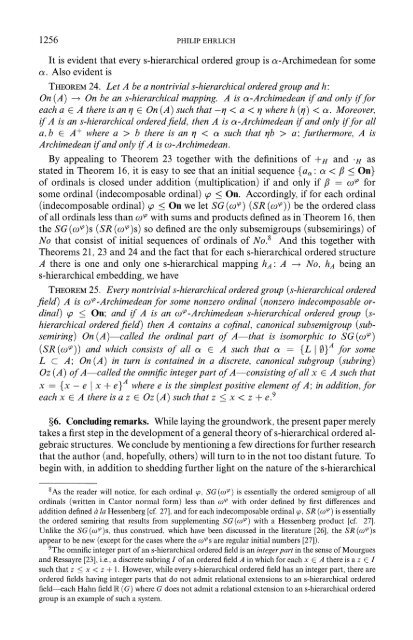Number Systems with Simplicity Hierarchies: A ... - Ohio University
Number Systems with Simplicity Hierarchies: A ... - Ohio University
Number Systems with Simplicity Hierarchies: A ... - Ohio University
Create successful ePaper yourself
Turn your PDF publications into a flip-book with our unique Google optimized e-Paper software.
1256 PHILIP EHRLICH<br />
It is evident that every s-hierarchical ordered group is a-Archimedean for some<br />
a. Also evident is<br />
THEOREM 24. Let A be a nontrivial s-hierarchical ordered group and h:<br />
On (A) -> On be an s-hierarchical mapping. A is a-Archimedean if and only iffor<br />
each a E A there is an q Ec On (A) such that -a < a < q where h (q) < a. Moreover,<br />
if A is an s-hierarchical ordered field, then A is a-Archimedean if and only iffor all<br />
a,b E A+ where a > b there is an q < a such that qb > a; furthermore, A is<br />
Archimedean if and only if A is co-Archimedean.<br />
By appealing to Theorem 23 together <strong>with</strong> the definitions of +H and H as<br />
stated in Theorem 16, it is easy to see that an initial sequence {a,: a < Pl < On}<br />
of ordinals is closed under addition (multiplication) if and only if P = w0 for<br />
some ordinal (indecomposable ordinal) p < On. Accordingly, if for each ordinal<br />
(indecomposable ordinal) p < On we let SG (aLP) (SR (ai)) be the ordered class<br />
of all ordinals less than w0 <strong>with</strong> sums and products defined as in Theorem 16, then<br />
the SG (aiP)s (SR (0i)s) so defined are the only subsemigroups (subsemirings) of<br />
No that consist of initial sequences of ordinals of No.8 And this together <strong>with</strong><br />
Theorems 21, 23 and 24 and the fact that for each s-hierarchical ordered structure<br />
A there is one and only one s-hierarchical mapping hA: A -* No, hA being an<br />
s-hierarchical embedding, we have<br />
THEOREM 25. Every nontrivial s-hierarchical ordered group (s-hierarchical ordered<br />
field) A is w0-Archimedean for some nonzero ordinal (nonzero indecomposable ordinal)<br />
p < On; and if A is an w0-Archimedean s-hierarchical ordered group (shierarchical<br />
ordered field) then A contains a cofinal, canonical subsemigroup (subsemiring)<br />
On (A) called the ordinal part of A that is isomorphic to SG (00)<br />
(SR (0P)) and which consists of all a Ec A such that a = {L I 0}A for some<br />
L C A; On (A) in turn is contained in a discrete, canonical subgroup (subring)<br />
Oz (A) of A called the omnific integer part of A consisting of all x E A such that<br />
x = {x - e I x + e}A where e is the simplest positive element of A; in addition, for<br />
each x E A there is a z E Oz (A) such that z < x < z + e.9<br />
?6. Concluding remarks. While laying the groundwork, the present paper merely<br />
takes a first step in the development of a general theory of s-hierarchical ordered algebraic<br />
structures. We conclude by mentioning a few directions for further research<br />
that the author (and, hopefully, others) will turn to in the not too distant future. To<br />
begin <strong>with</strong>, in addition to shedding further light on the nature of the s-hierarchical<br />
8As the reader will notice, for each ordinal A, SG (co9') is essentially the ordered semigroup of all<br />
ordinals (written in Cantor normal form) less than cow <strong>with</strong> order defined by first differences and<br />
addition defined a la Hessenberg [cf. 27], and for each indecomposable ordinal A, SR (cow') is essentially<br />
the ordered semiring that results from supplementing SG (co9') <strong>with</strong> a Hessenberg product [cf. 27].<br />
Unlike the SG (co9')s, thus construed, which have been discussed in the literature [26], the SR (co9')s<br />
appear to be new (except for the cases where the cow s are regular initial numbers [27]).<br />
9The omnific integer part of an s-hierarchical ordered field is an integer part in the sense of Mourgues<br />
and Ressayre [23], i.e., a discrete subring I of an ordered field A in which for each x E A there is a z E I<br />
such that z < x < z + 1. However, while every s-hierarchical ordered field has an integer part, there are<br />
ordered fields having integer parts that do not admit relational extensions to an s-hierarchical ordered<br />
field each Hahn field JR (G) where G does not admit a relational extension to an s-hierarchical ordered<br />
group is an example of such a system.
















